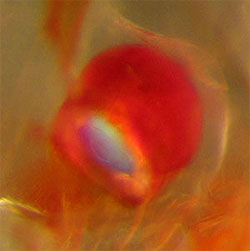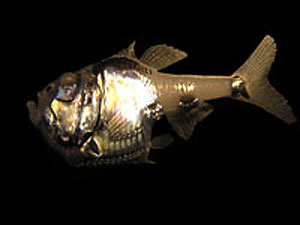GOTHENBURG, Sweden, Feb. 26, 2009 – The mystery of how some marine animals produce light has come one step closer to being solved. Researchers at the University of Gothenburg have discovered that krill, the luminous crustacean, can use special and previously unknown muscles to regulate light intensity.
The phenomenon of light emission by living organisms – bioluminescence – is quite common, especially in marine species. It is known that light is generated by chemical reactions in which oxygen molecules play an important part. In the animal world, these chemical reactions take place in special luminescent cells called photocytes.

‘Light switch’ muscles of the luminescent krill are shown.
Photocytes are aggregated into complex light organs in which the intensity of light is regulated by nerve impulses and in which light can be modulated with the help of reflectors, lenses and filters. By these means, organisms can adjust the wavelength, diffusion and intensity of light according to need. But the exact mechanisms behind these processes remain shrouded in mystery.
Jenny Krönström, a researcher in the department of zoology of the university has put another piece of the jigsaw puzzle in place by investigating the light organs of marine jellyfish, crustaceans and fish. In her thesis, she reveals that krill, the luminescent crustacean, is equipped with special muscles that regulate light intensity through contraction and relaxation.
Nitric oxide also is thought to play an important role in the bioluminescence of krill. It is produced in the small capillary vessels that keep the krill’s photocytes supplied with oxygen, as well as in special closure muscles, sphincters, that are located at the point where these capillaries distribute blood to the photocytes. Experiments with agents that make the sphincters contract or relax show that, when the sphincters relax, the krill begins to luminesce, presumably because of the increased flow of oxygenated blood to the photocytes.
The silver hatchetfish (Argyropelecus olfersii).
As bioluminescence has developed independently at several different points in evolution, various species have developed different methods of regulating and emitting light. Krönström’s research demonstrates that nitric oxide also has different effects in different species. In the remarkable deep sea silver hatchetfish (Argyropelecus olfersii), nitric oxide inhibits the light reaction, while in the plain midshipman fish (Porichthys notatus), it has an opposite, stimulating effect.
Biological light not only is useful to the organism itself as a biological torch, camouflage or as a means of communication, but the substances that are involved in the chemical luminescent reaction also have shown themselves to be useful in modern molecular biology, in which the discovery of green fluorescent protein, which produces green light in jellyfish, led to the Nobel Prize in chemistry as recently as 2008.
For more information, visit: www.gu.se